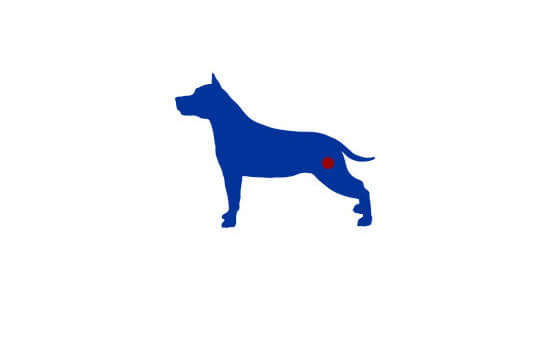
Hip Dysplasia (HD)
As with many other large breeds, the AmStaff may have a hip joint that may be affected by hip dysplasia. I am clearly saying MAY be affected in this sentence, because in practice it appears that the AmStaff is less affected by this condition of the hip than any other breed. This because it’s hip joint is very firmly spun with muscles. In addition, due to his extremely high tolerance level of pain, an American Staffordshire often will not indicate that he is suffering from it.
Development disorder
HD is a developmental disorder of the hip joint which can be caused by hereditary factors and/or external influences. In general, the better the hips of the parent animals, the smaller the chance that the offspring will develop HD. It is in no way a guarantee that progeny of negatively assessed dogs will also be negative, the chance is only greater.
Carefully handle your puppy
Regarding the external factors, we as breeders say it is very important to be very careful with your puppy and avoid things like jumping. The AmStaff’s puppy looks robust, but the bone structures contain growth discs that have to be completely closed during their growth. These growth discs will only close when the dog is between 5 and 14 months old. This closure is essential to eventually have an adult dog with a perfect body structure without any problems. HD is officially tested by X-rays of the hip joints. These photos are taken by a veterinarian and submitted for review to the Raad van Beheer. For the American Staffordshire Terrier, the minimum age for this study is 12 months.
Possible results
- HD A (free): The dog is X-ray free from hip dysplasia, which, however, does not mean that the dog cannot be a “carrier” of the aberration.
- HD B (Transition Form): Small changes have been found on the X-rays, which must be attributed to hip dysplasia, but no direct meaning that it can be transmitted to the offspring in the context of breeding.
- HD C (light positive): The X-ray shows that the dog has clear abnormalities, which can be contributed to the HD disease.
- HD D (positive): The X-rays show severe changes, contributed to the HD disease.
- HD E (Positive in Optima Forma): The hip joints are severely deformed.
It goes without saying that it is desirable to breed with HD free dogs. More information about HD, the assessment, etc. can be found on the website of the Raad van Beheer.
